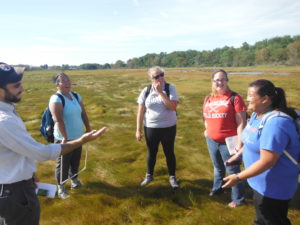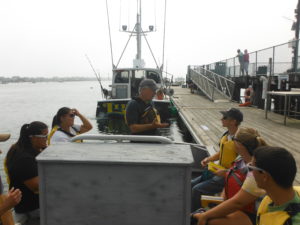After leaving the sandy beaches of Popham, we traveled south to the Wells National Estuarine Research Reserve. Dr. Teegarden switched for the weekend as Dr. Bernaki took over to lead the students through the ecology of plant species on salt marshes (as well as a slight background on birds). The students embarked on a study using image analysis of pictures they took along various transects they set out, to learn about zonation of marsh plants from the land to the ocean’s edge. Pretty easy, right?
The students started learning to use the software in a several hour long exercise as they went through the ‘demo’ of tracing objects on their computer screens. The following days they used their knowledge of the program and constructed their own experiments with the focus on how different species of plants appear in different areas. The students learned statistical approaches to design their experiments, to add rigor to their studies. The pictures were taken using a quadrat to define the study area of interest, and the saved images were then processed in the following days.
The following two days after the data collection were rainy and provided some much needed down time for everyone to get their work done.
After the long weekend, Dr. Teegarden returned as Dr. Bernaki collected the reports the students had worked so hard to complete. That afternoon we had a pleasant boat ride through Wells harbor, and the Webhannet River of the salt marsh. On the ride we learned much about the history of the area, and examined what could happen to the coastal town as sea level continues to rise. From there we packed up the van and continued on our journey to the Darling Marine Center, where we will be finishing off the marine ecology portion of the ESS.
-Andrew Merlino



